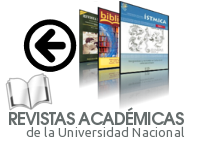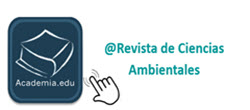A invasão de caminhos próximos às áreas protegidas altera a paisagem natural sonora devido à contaminação do barulho causada pelo trânsito na Costa Rica
DOI:
https://doi.org/10.15359/rca.52-1.2Palavras-chave:
antrofonia, biofonia, conservação da biodiversidade, conservação de paisagem sonora, geofonia, volume de trânsitoResumo
As estradas estão espacialmente dispostas nas paisagens e são utilizadas pelo trânsito, gerando barulho que pode afetar as áreas protegidas. O objetivo foi quantificar os trechos de estrada em contato com as áreas e nas proximidades delas, e investigar os efeitos que os parques podem sofrer com relação ao trânsito e ao barulho. Medimos trechos próximos às áreas utilizando o sistema de informação geográfica e o Atlas da Costa Rica. O barulho e o trânsito foram quantificados em três áreas adjacentes às estradas. Geramos mapas de barulho para avaliar a influência sobre os sons naturais, tais como os de riachos (geofonia) e aves (biofonia). Gravamos a biofonia perto e longe da estrada em uma das áreas. Descobrimos que 70 áreas protegidas são afetadas direta ou indiretamente pelas estradas. O barulho foi maior nas estradas com um maior uso veicular do que com um menor, mas os níveis de barulho também foram influenciados por tipo de veículo. O barulho penetrou no bosque com maiores níveis na estação seca do que na úmida. Descobrimos que a quantidade de biofonia em segundos foi menor perto da estrada e que o som do riacho foi dissimulado pelo barulho. Nossos resultados sugerem que o barulho contribui para a degradação do hábitat através da diminuição e perda de sons naturais, reduzindo a qualidade da proteção da biodiversidade. Deve ser considerada uma ação interdisciplinar e uma planificação rigorosa para evitar a adjacência de estradas sobre as áreas protegidas.Referências
Achilleos, G. A. (2011). The Inverse Distance Weighted interpolation method and error propagation mechanism – creating a DEM from an analogue topographical map. Journal of Spatial Science, 56(2), 283-304. Doi: 10.1080/14498596.2011.623348
Arévalo, J. E. and Knewhard, K. (2011). Traffic noise affects bird species in a protected tropical forest. Revista de Biología Tropical, 59(2), 969-980.
Arévalo J. E. and Ladle, R. J. (2016). Challenges to Forest Conservation. In: S. A. Molina-Murillo and C. Rojas (Eds.), The Paradigm of Forests and the Survival of the Fittest (pp. 172-195). USA: CRC Press. Doi: doi.org/10.1201/b19975-8
Arévalo, J. E., Honda, W., Arce-Arias, A. and Häger, A. (2017). Spatiotemporal variation of roadkills show mass mortality events for amphibians in a highly trafficked road adjacent to a national park, Costa Rica. Revista de Biología Tropical, 65(4), 1261-1276. doi: 10.15517/rbt.v65i4.27903
Caro, T. (2015). Roads through national parks: a successful case study. Tropical Conservation Science, 8(4): 1009-1016. Doi: 10.1177/194008291500800411
Chape, S., Harrison, J., Spalding, M. and Lysenko, I. (2005). Measuring the extent and effectiveness of protected areas as an indicator for meeting global biodiversity targets. Philosophical Transactions of the Royal Society B, 360(1454), 443-455. Doi: 10.1098/rstb.2004.1592
Coffin, A. W. (2007). From roadkill to road ecology: A review of the ecological effects of roads. Journal of Transport Geography, 15, 396-406. Doi: 10.1016/j.jtrangeo.2006.11.006
Dulac, J. (2013). Global land transport infrastructure requirements. Paris: International Energy Agency.
Eigenbrod, F., Hecnar, S. J. and Fahrig, L. (2009). Quantifying the Road-Effect Zone: Threshold Effects of a Motorway on Anuran Populations in Ontario, Canada. Ecology and Society, 14(1): 24. Doi: 10.5751/ES-02691-140124
Fahrig, L. (2003). Effects of habitat fragmentation on biodiversity. Annual Review of Ecology, Evolution, and Systematics, 34, 487-515. Doi: 10.1146/annurev.ecolsys.34.011802.132419
Farina, A. (2014). Soundscape Ecology: Principles, Patterns, Methods and Applications. Italy: Springer. Doi: 10.1007/978-94-007-7374-5
Francis, C. D., Ortega, C. P. and Cruz, A. (2010). Vocal frequency change reflects different responses to anthropogenic noise in two suboscine tyrant flycatchers. Proc. R. Soc. B., 282, 1-7. Doi: 10.1098/rspb.2010.1847
Forman, R. T. T., Sperling, D., Bissonette, J., Clevenger, A., Cutshall, C. D., Dale, V. H. and Winter, T. C. (2003). Road Ecology: Science and solutions. Washington D.C.: Island Press.
Francis, D. and Barber, J. R. (2013). A framework for understanding noise impacts on wildlife: an urgent conservation priority. Frontiers in Ecolology and the Environment, 11(6), 305-313. Doi: 10.1890/120183
Grade, A. M. and Sieving, K. E. (2016). When the birds go unheard: highway noise disrupts information transfer between bird species. Biology Letters, 12(4). Doi: 10.1098/rsbl.2016.0113
Holdridge, L. R. (1966). The life zone system. Adansonia, 6(2),199-203.
Hopcraft, J. G. C., Bigurube, G., Lembeli, J. D. and Borner, M. (2015). Balancing Conservation with National Development: A Socio-Economic Case Study of the Alternatives to the Serengeti Road. PLOS ONE, 10(7), e0130577. Doi: 10.1371/journal.pone.0130577
Kight, C. R. and Swaddle, J. P. (2015). Eastern Bluebirds Alter their Changes in the Acoustic Environment. Integrative and Comparative Biology, 55(3), 418-431. Doi: 10.1093/icb/icv070
Kleist, N. J., Guralnick, R. P., Cruz, A. and Francis, C .D. (2016). Anthropogenic noise weakens territorial response to intruder's songs. Ecosphere, 7(3), e01259. Doi: 10.1002/ecs2.1259
Laurence, W. F., Goosem, M. and Laurance, S. G. W. (2009). Impacts of roads and linear clearings on tropical forests. Trends in Ecology and Evolution, 24(12), 659-669. doi: 10.1016/j.tree.2009.06.009
Laurance, W. F., Peletier-Jellema, A., Geenen, B., Koster, H., Verweij, P., Van Dijck, P. and Van Kuijk, M. (2015). Reducing the global environmental impacts of rapid infrastructure expansion. Current Biology Magazine, 25, R255–R268. Doi: 10.1016/j.cub.2015.02.050
Leonard, R. J. and Hochuli, D. F. (2017). Exhausting all avenues: why impacts of air pollution should be part of road ecology. Frontiers in Ecology and the Environment, 15(8), 1-7. Doi: 10.1002/fee.1521
Marsh, D. M., Cosentino, B. J., Jones, K. S., Apodaca, J. J., Beard, K. H., Bell, J. M. and Vonesh, J. R. (2016). Effects of roads and land use on frog distributions across spatial scales and regions in the Eastern and Central United States. Diversity and Distributions, 23(2), 1-13. Doi: 10.1111/ddi.12516
McClure, C. J. W., Ware, H. E., Carlisle, J., Kaltenecker, G. and Barber, J. R. (2013). An experimental investigation into the effects of traffic noise on distributions of birds: avoiding the phantom road. Proceedings of the Royal Society B, 280(1773), 1-9. Doi: 10.1098/rspb.2013.2290
Monge-Nágera, J. (1996). Vertebrate mortality on tropical Highways: The Costa Rican case. Vida Silvestre Neotropical, 5(2), 154-156.
Payne S. R., Davies, W. J. and Adams, M. D. (2009). Research into the Practical and Policy Applications of Soundscapes Concepts and Techniques in Urban Areas (NANR 200). London: DEFRA.
Pomareda, E. (Octuber 17th 2012). Una amenaza real de atropellos de animales silvestres. Seminario Universidad. Recuperado de https://semanariouniversidad.com/opinion/una-amenaza-real-atropello-de-animales-silvestres/
Potvin D. A., Parris, K. M. and Mulder, R. A. (2011). Geographically pervasive effects of urban noise on frequency and syllable rate of songs and calls in silvereyes (Zosterops lateralis). Proceeding of the Royal Society B, 278(1717), 2464-2469. Doi: 10.1098/rspb.2010.2296
Phillips, C. J. C. (2009). Housing, handling and the environment for cattle. Principles of cattle production (chapter 5). Modular Texts, Queensland, Australia. Doi: 10.1079/9781845933975.0095
Proppe, D. S., Sturdy, C. B. and St. Clair, C. C. (2013). Anthropogenic noise decreases urban songbird diversity and may contribute to homogenization. Global Change Biology, 19(4), 1075-1084. Doi: 10.1111/gcb.12098
Reijnen, R., Foppen, R., Ter Braak, C. and Thissen, J. (1995). The Effects of Car Traffic on Breeding Bird Populations in Woodland. III. Reduction of Density in Relation to the Proximity of Main Roads. Journal of Applied Ecology, 32(1), 187-202. Doi: 10.2307/2404428
Rojas-Chacón, E. (2011). Atropello de vertebrados en una carretera secundaria en Costa Rica. Cuadernos de Investigación UNED, 3(1), 81-84. Doi: 10.22458/urj.v3i1.209
Rodewald, A. D. (2003). The importance of land uses within the landscape matrix. Wildlife Society Bulletin, 31(2), 586-592. Recovered from http://www.jstor.org/stable/3784344
Slabbekoorn H. (2013). Songs of the city: Noise-dependent spectral plasticity in the acoustic phenotype of urban birds. Animal Behaviour, 85(5), 1089-1099. Doi: 10.1016/j.anbehav.2013.01.021
Schmidt, R., Morrison, A. and Kunc, H. P. (2014). Sexy voices e no choices: male song in noise fails to attract females. Animal Behaviour, 94, 55-59. Doi: 10.1016/j.anbehav.2014.05.018
Shannon, G., McKenna, M. F., Angeloni, L. M., Crooks, K. R., Fristrup, K. M., Brown, E. and Wittemyer, G. (2016). A synthesis of two decades of research documenting the effects of noise on wildlife. Biological Reviews, 91(4), 982-1005. Doi: 10.1111/brv.12207
SINAC (Sistema Nacional de Áreas de Conservación). (2011). Políticas para las Áreas Silvestres Protegidas (ASP) del Sistema Nacional de Áreas de Conservación (SINAC). Recovered from http://www.sinac.go.cr/ES/docu/ASP/Pol%C3%ADticasASPSINAC2011.pdf
Soutullo, A. (2010). Extent of the Global Network of Terrestrial Protected Areas. Conservation Biology, 24(2), 362-362. Doi: 10.1111/j.1523-1739.2010.01465.x
TEC (Instituto Tecnológico de Costa Rica). (2014). Atlas de Costa Rica. Recovered from https://repositoriotec.tec.ac.cr/handle/2238/6749?show=full
Van der Ree, R., Smith, D. J. and Grilo, C. (2015). The ecological effects of linear infrastructure and traffic: challenges and opportunities of rapid global growth. In: R. Van der Reed, D. J. Smith and C. Grilo (Eds). The handbook of road ecology (pp. 1-9). U. K.: Wiley Blackwell. Doi: 10.1002/9781118568170.ch1
Downloads
Publicado
Como Citar
Edição
Seção
Licença
A partir del 17 de mayo del 2018 la licencia ha sido actualizada a:

Esta obra está bajo una Licencia Creative Commons Atribución-NoComercial-CompartirIgual 4.0 Internacional.














